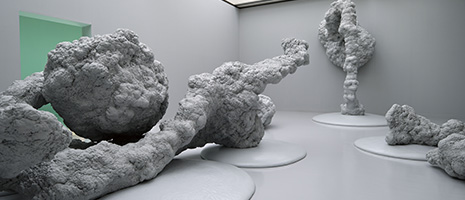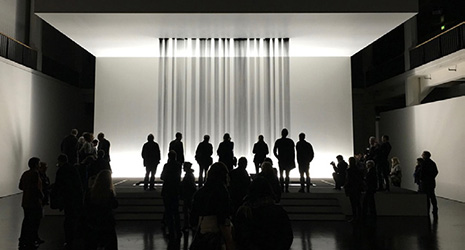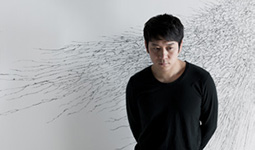Home > Highlighting JAPAN > Highlighting Japan August 2016 > Innovative Artists
Highlighting JAPAN


Immaterial World
Sculptor Kohei Nawa, a contributing artist in the “Tokyo Caravan” event being held worldwide in the run up to the 2020 Tokyo Games, produces work that challenges conventional notions of production and perception.
Kohei Nawa is a leading sculptor who has been implementing a variety of projects in Japan and abroad. His works are not always sculptures in the conventional sense.
“PixCell-Deer#24,” a piece in Nawa’s “BEADS” series, for example, is a stuffed deer completely covered with transparent glass beads of various sizes. Viewers clearly understand the presence before them is a deer, but they cannot see its body surface directly. Instead, the countless glass beads act as lenses onto details of the deer’s body such as its hair when viewed up close.
Nawa bought the stuffed deer on the Internet.
“When I saw anything of substance on the Internet displayed on the monitor as a mere collection of pixels, as the Internet became widespread, I felt that everything and every landscape would come to be computerized one after another,” he says.
Digital images, which we casually receive every day, appear to undergo a complete change when their resolution is adjusted. “BEADS” is a series of experimental works aimed at freshly visualizing this notion or effect.
Nawa has created series using a variety of materials that sculptors have traditionally avoided, such as the “SCUM” series using expanded polyurethane, and the “LIQUID” series using silicone oil. An idea called “CELL” is at the root of these series. “CELL” is a unit comprising human perceptions, as well as the given meaning of organic cells. The pixel, a unit comprising digital information, is also designed based on the principle of human perceptions.
“I think facing materials and space and expressing a theme are forming sculpture,” explains Nawa. “Materials have a variety of physical properties. That’s why I sometimes use liquids. For example, I think it’s possible to produce a ‘sculptural’ experience using sounds as materials, too.”
Nawa’s studio is located in Fushimi, a suburb of Kyoto, where he spent his university years. The old private houses that remain along this riverside area are blessed with many trees and tranquility, an atmosphere for which Kyoto is well known. The studio is a renovated sandwich factory, hence its name, SANDWICH. Nawa has turned this studio into a production base for fellow artists along with staff members and students from Kyoto University of Art & Design, where he teaches. SANDWICH adopts a production approach called “creative platform” that assembles a team of artists and craftsmen working in different genres, project by project.
“I liken it to ships,” says Nawa. “The image is to put different crew members on a ship for each project and row out to a destination together. Different people aim at completing one thing together using different approaches, without restrictions on materials, fields or methods.”
The fields Nawa works in are increasingly expanding thanks to this open platform. Nawa has recently begun managing projects such as the design of Koutei, an art pavilion at Mt. Tenshin Shinsho-ji temple in Hiroshima Prefecture, and the stage design for “VESSEL,” a collaborative dance performance with Belgian choreographer Damien Jalet.
© 2009 Cabinet Office, Government of Japan








